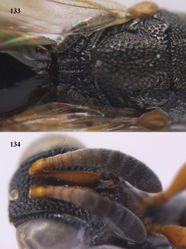Haltichella
| Notice: | This page is derived from the original publication listed below, whose author(s) should always be credited. Further contributors may edit and improve the content of this page and, consequently, need to be credited as well (see page history). Any assessment of factual correctness requires a careful review of the original article as well as of subsequent contributions.
If you are uncertain whether your planned contribution is correct or not, we suggest that you use the associated discussion page instead of editing the page directly. This page should be cited as follows (rationale):
Citation formats to copy and paste
BibTeX: @article{Narendran2016ZooKeys, RIS/ Endnote: TY - JOUR Wikipedia/ Citizendium: <ref name="Narendran2016ZooKeys">{{Citation See also the citation download page at the journal. |
Ordo: Hymenoptera
Familia: Chalcididae
Name
Haltichella Spinola, 1811 – Wikispecies link – Pensoft Profile
- Haltichella Spinola, 1811: 148. Type species: Chalcis bispinosa Fabricius; proposed by Masi (1929a)[1] (= Chalcis rufipes Olivier; as proposed by Schmitz (1946)[2]).
- Halticella Stephens, 1829: 36. Unjustified emendation.
- Microchalcis Kieffer, 1905: 255. Type species: Microchalcis quadridens Kieffer, by monotypy (synonymised with Haltichella Spinola by Bouček (1952)[3]).
- Haltichellodes Steffan, 1955: 384. Type species: Haltichella pulla Steffan, (by monotypy, described as subgenus of Haltichella and synonymised Haltichella Spinola by Bouček 1988b[4]).
Diagnosis
This genus comes very near Neohaltichella Narendran in the key to Oriental genera of Chalcididae by Narendran (1989)[5], but differs from Neohaltichella in having: 1) base of T1 with longitudinal carinae (in Neohaltichella T1 without any carinae); 2) T1 relatively larger than that of Neohaltichella; 3) head and mesosoma less stout than that of Neohaltichella, and 4) body not densely pubescent (in Neohaltichella body densely pubescent).
Description
Hind tibia with an additional carina externally, T1 with at least a pair of longitudinal carinae at base; often supplemented by additional striae or carinae which are often anteriorly united by a transverse carina; T1 relatively larger (exceeding mostly half of metasoma or reaching middle of metasoma); apex of scutellum bi-dentate or bi-lobed; pronotum with anterior carina absent or confirmed to lateral thirds; dorsal part of horseshoe-shaped carina indistinct or irregular.
Hosts
Noyes (2011)[6] listed the following families of Lepidoptera (Bucculatricidae; Gelechiidae; Momphidae; Notodontidae; Oecophoridae; Pyralidae; Tortricidae) and Hymenoptera (Braconidae; Ichneumonidae).
Distribution
Cosmopolitan (Bouček 1988b[4]; Noyes 2011[6]).
Key to Vietnamese species of Haltichella Spinola (based on females)
Taxon Treatment
- Narendran, T; van Achterberg, C; 2016: Revision of the family Chalcididae (Hymenoptera, Chalcidoidea) from Vietnam, with the description of 13 new species ZooKeys, (576): 1-202. doi
Images
|
Other References
- ↑ Masi L (1929a) Contributo alla conoscenza dei calcididi orientali della sottofamiglia Chalcidinae. Bollettino del Laboratorio di Entomologia del R. Istituto Superiore Agrario di Bologna 2: 155–188.
- ↑ Schmitz G (1946) Chalcididae de l’Afrique Central. Exploration du Parc National Albert, Mission G. F. de Witte. Fasc. 48: 1–191.
- ↑ Bouček Z (1952) The first revision of the European species of the family Chalcididae (Hymenoptera). Sborník Entomologického Oddeleni Národního Musea v Praze 27 (supplement 1): 1–108. [17 plates]
- ↑ 4.0 4.1 Bouček Z (1988b) Australasian Chalcidoidea (Hymenoptera) – A biosystematic revision of genera of fourteen families, with a reclassification of species. CAB International, Wallingford, 832 pp.
- ↑ Narendran T (1989) Oriental Chalcididae (Hymenoptera: Chalcidoidea). Zoological Monograph. Department of Zoology, University of Calicut, Kerala, 1–441.
- ↑ 6.0 6.1 Noyes J (2011) Universal Chalcidoidea Database. http://www.nhm.ac.uk/chalcidoids







